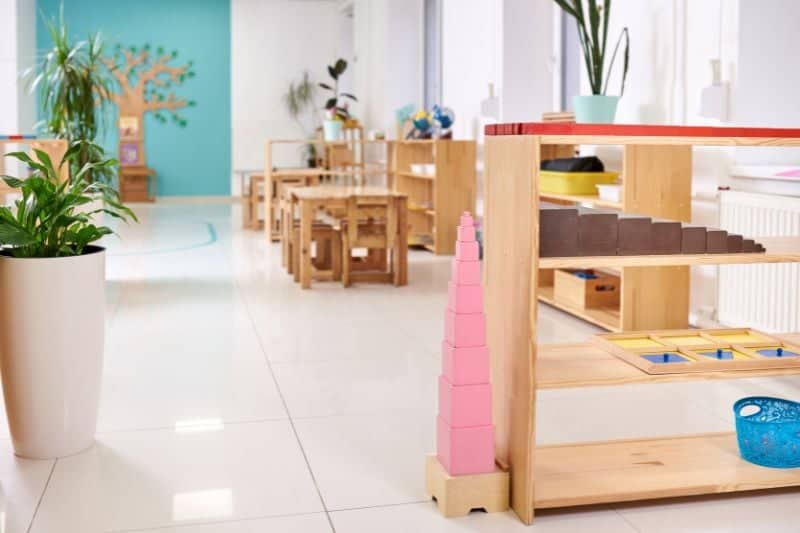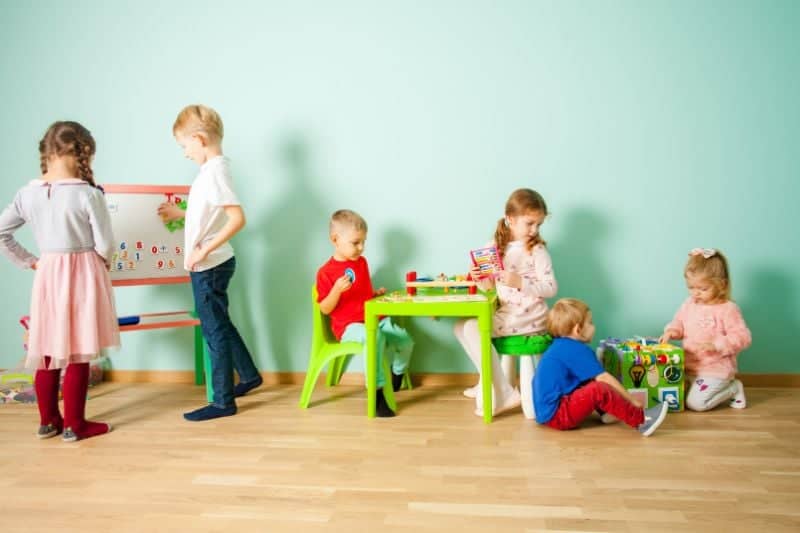The Montessori education method was developed by Italian physician and educator Maria Montessori in the late 19th century.
It has transformed early childhood education around the world promoting independence, fostering a love for learning, and supporting holistic development.
A little bit of History: Maria Montessori
Maria Montessori was an Italian physician and educator who developed the Montessori method. She was the first female physician in Italy.
Her approach to education was child-centered and emphasized independence, freedom within limits, and respect for the child’s natural development.
Today, the Montessori method is widely recognized, and many schools follow its principles and teaching philosophy.
Montessori Principles and Philosophy
Child-Centered Approach
The Montessori approach is centered on the child, emphasizing the child’s natural curiosity and desire to learn.
Children are encouraged to explore their environment and learn at their own pace.
Prepared Environment
The environment is carefully prepared to meet the needs of the child and designed to be safe, orderly, and aesthetically pleasing.

Materials are carefully selected and arranged to promote exploration and learning. Materials are separated by practical life, sensorial, math, and language areas.
Role of the Montessori Teacher
The Montessori teacher serves as a guide and facilitator, rather than a lecturer or disciplinarian.
The teacher observes and supports the child’s learning, providing guidance and encouragement as needed.
Mixed-Age Groupings
Children of different ages are grouped together in the Montessori classroom.
This allows for peer learning, with older children serving as mentors and role models for younger children.

By teaching younger children, older children learn to be patient and emphatic, to communicate effectively, and to share knowledge.
Practical Life Activities
Practical life activities, an important part of the Montessori curriculum, include pouring, sweeping, and buttoning, helping children develop fine motor skills and independence.
Sensorial Education
Children are encouraged to explore and learn through their senses, with materials designed to promote sensory development.
Sensorial education is a key component because it promotes brain-nerve connections by stimulating their senses.
It boosts memory and helps them accomplish more difficult tasks later on.
I wrote an article of best busy boards for toddlers.
Language and Literacy
Children are exposed to a rich language environment, with materials designed to promote reading, writing, and communication skills.
Mathematics
Children are introduced to mathematical concepts through hands-on materials, allowing them to develop a deep understanding of mathematical concepts.
Components of a Montessori Classroom
Montessori Learning Materials
In a Montessori classroom, learning materials play a crucial role in facilitating hands-on, experiential learning. The materials are designed to be self-correcting, allowing children to learn through trial and error.
They are also aesthetically pleasing, inviting children to engage with them.
Montessori materials are organized into different categories, including practical life, sensorial, language, math, and cultural subjects.
Each category has its own set of materials that are designed to help children develop specific skills and knowledge.
Classroom Layout
The layout of a Montessori classroom is carefully designed to create a prepared environment that supports children’s learning and development.
The classroom is divided into different areas, each with its own set of materials and activities. The areas include practical life, sensorial, language, math, cultural subjects, and art.
Each area is designed to be visually appealing and inviting to children.
The furniture and materials are child-sized, allowing children to move and work independently. The classroom is also designed to be open and spacious, allowing for movement and exploration.
Daily Routines
In a Montessori classroom, daily routines are an essential part of the learning experience. Routines provide children with a sense of structure and predictability, which is important for their emotional well-being.
The routines include activities such as circle time, individual work time, snack time, outdoor play, and group activities.
Circle time is an opportunity for children to come together as a group and engage in activities such as singing, storytelling, and discussion.
Individual work time is a time for children to work independently with the materials.
Snack time is an opportunity for children to socialize and practice practical life skills.
Outdoor play is an opportunity for children to engage in physical activity and explore the natural world. Group activities are an opportunity for children to work together and practice social skills.
Freedom within Limits
One of the core principles of Montessori education is the idea of freedom within limits. This means that children are given the freedom to choose their own work and work at their own pace, but within a structured and supportive environment.
Children are encouraged to follow their interests and passions, and to work on projects that are meaningful to them.
At the same time, they are guided and supported by trained Montessori teachers who provide individualized instruction and feedback.
The freedom within limits approach helps children develop self-discipline and self-motivation, while also fostering a sense of responsibility and respect for others.
Benefits of Montessori Education Method
As someone who has learned about Montessori education method, I can confidently say that it offers several benefits to students. Here are some of the advantages of Montessori education:
Cognitive and Academic Advantages
Montessori education encourages students to learn at their own pace and explore their interests.
This approach helps students develop a love of learning and a sense of curiosity that can last a lifetime.
Additionally, Montessori students often perform well academically, with research suggesting that they may have better math and reading skills than their peers in traditional education systems.
Development of Life Skills
Montessori education emphasizes the development of life skills, such as independence, self-motivation, and problem-solving.
Students are given the freedom to make decisions, take risks, and learn from their mistakes.
This approach helps children develop a sense of responsibility and self-confidence that can serve them well throughout their lives.
Positive Social-Emotional Growth
Montessori education fosters positive social-emotional growth in students. Students learn to work collaboratively, communicate effectively, and respect others.
Additionally, Montessori classrooms are often multi-age, which allows younger students to learn from older ones and older students to develop leadership skills. This approach helps students develop a strong sense of community and empathy for others.
In conclusion, Montessori education offers several benefits to students, including cognitive and academic advantages, the development of life skills, and positive social-emotional growth.
Comparing Montessori Education to Traditional Education Models
Teaching Methodologies
In Montessori education, the teaching methodology is child-centered. Students are encouraged to learn at their own pace and explore their interests. The teacher acts as a guide, providing materials and activities that align with the student’s individual needs.
Traditional education, on the other hand, is teacher-centered. The teacher is the primary source of information and students are expected to learn through lectures and textbooks.
Classroom structure and dynamics
Montessori classrooms are designed to be calm and peaceful, with minimal distractions and a focus on individual work.
Students are encouraged to collaborate and help each other, but ultimately, they are responsible for their own learning.
Traditional classrooms tend to be more structured, with desks arranged in rows and a focus on group work and teacher-led instruction.
Role of assessments and grades
Montessori education places less emphasis on grades and standardized testing. Instead, students are evaluated based on their progress and mastery of skills.
Traditional education relies heavily on grades and standardized testing to measure student progress and achievement.
Outcomes and effectiveness
Research has shown that Montessori education can lead to positive outcomes such as improved academic performance, social and emotional development, and problem-solving skills.
However, it is important to note that there is limited research comparing Montessori education to traditional education models, and the effectiveness of Montessori education may vary depending on the context and implementation. Nevertheless, research suggests that high fidelity Montessori implementation leads lo better outcomes than lower fidelity ones.
Overall, Montessori education and traditional education models have distinct differences in teaching methodologies, classroom structure and dynamics, role of assessments and grades, and outcomes and effectiveness.
Parents and educators should carefully consider these differences when deciding which model is best for their children.
Challenges and Criticisms
Misconceptions about Montessori Education
There are several common misconceptions about Montessori education that can lead to criticism. One of the most common is the belief that Montessori schools are unstructured and lack discipline.
In reality, Montessori classrooms are highly structured and emphasize self-discipline and responsibility.
Another misconception is that Montessori education is only for gifted or advanced students. In fact, Montessori education is designed to meet the needs of all students, regardless of their academic abilities.
Potential Drawbacks and Areas of Concern
While Montessori education has many benefits, there are also potential drawbacks and areas of concern.
One concern is that Montessori classrooms may not provide enough opportunities for socialization and group work. I don’t think this is the case because in-person education in classrooms encourages socialization, vs., for example, home-schooling.
Another concern is that the emphasis on individual learning may not be suitable for all students, particularly those who thrive in more traditional classroom settings.
Additionally, some critics argue that Montessori education is too expensive and not accessible to all families.
Addressing the Criticisms: Montessori in Modern Times
In recent years, Montessori education has evolved to address some of the criticisms and concerns that have been raised.
Many Montessori schools now incorporate more group work and socialization opportunities into their curriculum.
Additionally, some Montessori schools have begun to offer more traditional classroom settings alongside their Montessori programs, providing families with more options.
Finally, many Montessori schools have implemented scholarship programs and financial aid to make Montessori education more accessible to a wider range of families.
Frequently Asked Questions
What are the principles of Montessori education method?
Montessori education is based on the principles of child-centered learning, respect for the child, and a prepared environment.
The Montessori philosophy believes that children are naturally curious and motivated to learn, and that they learn best when they are given the freedom to explore and discover on their own.
How does Montessori education differ from traditional education?
Montessori education differs from traditional education in several ways. In Montessori, children are given the freedom to choose their own activities and work at their own pace.
They are also encouraged to collaborate with their peers and learn from one another.
In contrast, traditional education tends to be more teacher-centered, with the teacher directing the learning and the students expected to follow along.
What is the Montessori method of teaching?
The Montessori method of teaching is based on the idea that children learn best when they are given the freedom to explore and discover on their own.
The teacher acts as a guide, providing materials and activities that are designed to stimulate the child’s curiosity and encourage independent learning.
What are some Montessori activities?
Montessori activities are designed to be hands-on and interactive, allowing children to explore and discover on their own.
Some examples of Montessori activities include practical life skills, sensorial activities, language and literacy activities, math and science activities, and cultural activities.
For example, classic Montessori activities are the pink tower, sandpaper letters, moveable alphabet, golden beads and water pouring.
What is the main purpose of Montessori education?
The main purpose of Montessori education method is to help children develop into independent, self-motivated learners who are capable of pursuing their own interests and passions.
Montessori education also aims to foster a love of learning and a sense of respect for oneself, others, and the environment.
How do Montessori toys support learning?
Montessori toys are designed to be simple, open-ended, and based on real-life experiences.
They are meant to encourage exploration, creativity, and problem-solving skills.
Montessori toys also help children develop fine motor skills, hand-eye coordination, and concentration.
Hi I’m Ana. I’m all about trying to live the best life you can. This blog is all about working to become physically healthy, mentally healthy and financially free! There lots of DIY tips, personal finance tips and just general tips on how to live the best life.

Leave a Reply